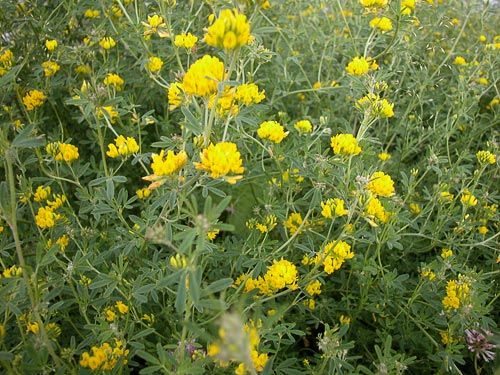Crops
Medicago falcata L. - Yellow flower alfalfa, sickle-shaped alfalfa.
Taxonomic position.
Family Leguminosae Endl., genus Medicago L., subgenus Falcago (Reichb.) Grossh.Biology and morphology.
2n =16, 32. Perennial herb. Root system is well-developed; root type depends on environmental conditions (main-rooted, rhizomatous and creeping-root forms of the plant exist). Stems are numerous, ascending, erect or procumbent, 20-150 cm tall (usually 40-80 cm), glabrous or covered with sparse hairs. Leaflets vary in shape and size, are obovate, oblong, oval or broadly ovate, 2-30 mm in length (usually 5-22 mm) and 1-10 mm in width (usually 2-6 mm). Racemes are oval, dense on short peduncles. Flowers are yellow. Pods comparatively small, sickle-shaped or straight with sparse hairs, 6-15 m in length (usually 8-12) and 2-3.5 mm in width. Blossoms in July-August. Seeds ripen in September-October. Cross-pollinated by several types of bee - honey, short-tongued cutter, alkali and bumble bees.Distribution.
Began to be cultivated in the 19th century. Cultivated on small plots in forest and steppe areas in 28 regions and republics of the former USSR. 4 breeding cultivars have received state approval for cultivation. Is not widely distributed due to difficulties with seed production.Ecology.
Alfalfa is well-adapted to a wide range of climatic and soil conditions, but it grows best in deep, loamy, well-drained soils. It is relatively drought-tolerant but also responds well to irrigation. It tolerates some alkalinity but does not do well in highly alkaline conditions. Tolerates salty soils. It is tolerant of flooding, water-logging and poor soil drainage. It will withstand long periods of flooding if they occur before growth begins in the spring.Utilization and economic value.
Characterized by high ecological plasticity. More frost-resistant than Medicago sativa L. and is therefore more easily grown in extreme environmental conditions. Suitable for growing without irrigation in steppe and partially wooded steppe in both hemispheres. Perenniality and upright growth habit make it a highly suitable crop for hay, silage or in dehydrated form. Usually productive for 8-16 years. Its numerous cultivars with differing characteristics exhibit an ability to grow in environments ranging from very dry to very cold. Grown in monoculture and in mixture. Has a higher tolerance for saline soils than many other forage species. Rich in protein, minerals and vitamins. Feeding value largely determined by stage of growth at the time of utilization, since nutritive value declines with advancing maturity and an increase in stem:leaf ratio. Increasing the number of crops in a season by cutting at earlier stages of growth improves forage digestibility and crude protein content but at the expense of yield. In comparison with grass at similar stages of growth, lucerne has lower cell wall and digestible fiber contents but higher digestible cell and crude protein contents. It also has a higher content of most minerals of nutritional importance to livestock. Drought-resistant. Suited to intensive grazing. Is not widely distributed due to difficulties with seed production. Valuable crop in arable and organic systems on account of its N-fixation ability and as a source of organic matter. Forage mass productivity ranges from 7.5-15.0 MT/ha; hay productivity ranges from 2.5-7.5 MT/ha; seed productivity ranges from 50-300 kg/ha. It is an excellent source of nectar and pollen for honey bees. Susceptible to many pests and diseases. May cause bloat in ruminants. Plant saponins may interact with rumen bacteria and cause haemolysis in animals.Literature cited:
Catalog of state-permitted cultivars of agricultural crops. 1969. - M.: Kolos, 489 pp. (in Russian).Catalog of state-permitted cultivars of agricultural crops. 1971. - M.: Kolos, 488 pp. (in Russian).
Catalog of state-permitted cultivars of agricultural crops. 1974. - M.: Kolos, 480 pp. (in Russian).
Catalog of state-permitted cultivars of agricultural crops. 1985. - M.: Kolos, Vol 3. - 489 pp. (in Russian).
Catalog of agricultural crop cultivars permitted in Byelorussia. 1985. - Minsk: Uradjai, 176 pp. (in Russian).
Golovkin B.N. 1988. Cultigenic plant area. - M.: Nauka, 184 pp. (in Russian).
Kashtanov A.N., ed. 1983. The Natural agricultural regions and utilization of soil resources of the USSR. - M.: Kolos, 336 pp. (in Russian).
Medvedev P.F., Smetannikova A.I. 1981. The forage crops of the European part of the USSR. - L.: Kolos, 336 pp. (in Russian).
Shashko D.N. Agroclimatic region of the USSR. 1967. - M.: Kolos, 335 pp. (in Russian).
Shashko D. N. 1985. Agroclimatic resources of the USSR. - M.: Kolos, 248 pp. (in Russian).
Soil resources of the USSR (Agricultural regions of areas and republics of USSR). 1990. - M.: - Vol 1. - 260 pp. (in Russian).
State register of Ukrainian plant cultivars. 1992. - Kiev: Urojai, 199 pp. (in Russian).
State register of breeding achievements permitted for utilization. Plant cultivars. 1994. - M.: - 218 pp. (in Russian).
State register of breeding achievements permitted for utilization. Plant cultivars. 1996. - M.: - 171 pp. (in Russian).
State register of breeding achievements permitted for utilization. Plant cultivars. 1999. - M.: - 192 pp. (in Russian).
State register of breeding achievements permitted for utilization. Plant cultivars. 2000. - M.: - 232 pp. (in Russian).
State register of breeding achievements permitted for utilization. Plant cultivars. 2001. - M.: - 252 pp. (in Russian).
State register of breeding achievements permitted for utilization. Plant cultivars. 2003. - M.: - 236 pp. (in Russian).
The register of plant cultivars in Ukraine. 1996. - Kiev: Urojai, 259 pp. (in Russian).


